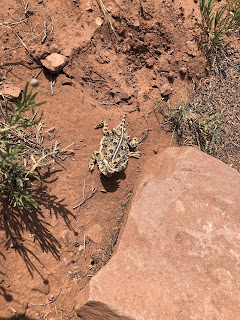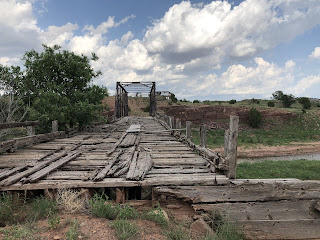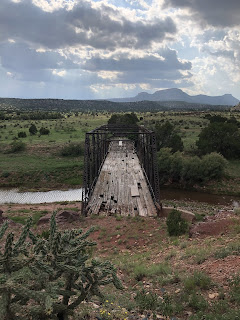Is this not beautiful country? New Mexico captured my heart many years ago and never fails to recapture it. This is the road--such as it is--to an abandoned town that I dare not name. The nearest hill is known as Mesa Lauriano.
Exploring this ghost-town was the highlight of my week-long trip out West. And yet, I cannot tell the name of this place because it would be a betrayal to the friendly cowboy who gave us permission to visit this place.
This old town site is extremely isolated, deep inside a very large private ranch. Two young cowboys found me inspecting the chained gate leading into the ranch, and they kindly gave me the phone number of the ranch manager. These broad vistas and striking views are reserved for ranch hands and cowpokes...and cows, of course.
But with a lot of persistence and the right map, you'll find the ancient Spanish settlement, some of which is surprisingly still intact. It's a five mile walk from the last cattle guard, and take careful note of the trail you take because it's possible to get lost on your way back. My friend and I did...and you should have heard him moaning about it....
With a roof, this old house would still offer shelter from the elements.
One house had an old tin ceiling collapsing into one of its two rooms.
Click on this photo to enlarge it. There are several homes visible here.
The road into this place is barely visible even by daylight, but people were still traveling it as recently as the early 2000s in order to visit loved ones in the village cemetery--which we never found.
We did meet a few reptilian friends along the way, like this horny toad.
My friend nearly stepped on this rattlesnake on the long trudge home--as we frantically looked for traces that we had passed along that same road on the way to the town. We may or may not have gotten slightly lost, or at least confused about our route, on the way back to the campsite.
And this little fellow was the only one home when we visited one of the larger houses in the village.
This is the first building you see in the town, approaching from the north.
Click on this photo to see the window in the middle where the old wooden latticework is still partly intact.
The tufted clouds above complement the tufted ground below.
This particular town has all sorts of artifacts on the ground outside the buildings. Old pieces of broken glass. Shards of patterned china. Old hardware, tools, and bits of unknown paraphernalia.
When these adobe bricks erode, they simply return to the earth--which is how buildings ought to be: biodegradable.
See the bare ribcage of a long-gone roof above this otherwise sturdy stone house, with similarly shaped mountains in the distance. The architecture here seems to rise right out of the earth, and it returns into the earth so gracefully.
One of the handsomest structures in town was probably once a mechanic's shop where cars were repaired. Look at the excellent stonework.
Once again, the stone-laying is perfect--crisp, even, straight, and tight--and yet entirely without mortar. It makes use of a variety of stone sizes, and colors, and shapes to create a beautiful composition of stonework. At first glance, it's simple and easy to overlook. At second glance, every simple two-room house is a work of art--deceptively intricate in its stony design.
My favorite building was this little homestead. Some of the paneled wooden doors were still standing in their doorways. Ceilings, floors, and walls were still solid--probably due to its good roof.
Here's the interior. This house was almost entirely intact, aside from broken windows and a whole lot of crud. Clean it up, close up the windows, and it could be a home again.
From a distance, the barn, ranch house, and corral here seemed like they were still in use. This is the newest architecture in town, and the windmill in the background just keeps pumping away in the dry western wind.
The ranch manager told us that the last inhabitant left the town in 1982--though most left before that time. I'm pretty sure this little white ranch house is where that last townsperson lived. Click on this photo to see the rusty can of Dinty Moore beef stew on the counter with another in the cupboard. It was probably an overnight shelter for cowhands.
But the town's crowning glory is its crumbling bridge across the Gallinas River!
And I use the term "river" lightly. It's more a string of stagnant mud puddles. Here's the bridge and the river as seen from above.
Some interior shots...
A room with a view.
I would happily live here, wouldn't you?
This building was large and low with two very big rooms. I'm guessing it was once a barn.
We never did find the cemetery that belongs to this town--and all these old ghost-towns have charming cemeteries filled with humble gravestones etched with simple Spanish folk art. But there were plenty of open water wells, most of them dry as dust and plenty dangerous. We almost took the wrong road on the way back to our campsite, 5 miles away, and had a very anxious march back to our tent. "Is this the right road? I don't know. Do you see our footprints headed the other direction? I don't think so." Ah, but we made it back alright. The moon came up full and glorious, and it lit the cool night with a glory I've rarely known. The Buck Moon, my friend's wife called it.






























































